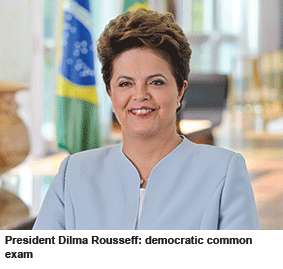Brazil: Public-private schools gap
 When this year’s essay title in Brazil’s national high school exam raised the question of violence against women, it opened up a nationwide debate. Cited as growing evidence of the country’s progress on women’s rights, it was equally condemned as a form of indoctrination by the hard-line evangelical caucus. Yet the controversy it provoked also reflected the importance placed on the single two-day test, the Enem, which has emerged as the country’s de facto university entrance exam.
When this year’s essay title in Brazil’s national high school exam raised the question of violence against women, it opened up a nationwide debate. Cited as growing evidence of the country’s progress on women’s rights, it was equally condemned as a form of indoctrination by the hard-line evangelical caucus. Yet the controversy it provoked also reflected the importance placed on the single two-day test, the Enem, which has emerged as the country’s de facto university entrance exam.
Since it was created in 1998, Enem has become the biggest nationwide test in the world after the National Higher Education Entrance Examination, or gao kao, in China, taken by more than 9 million students. While the Chinese exam has a formidable reputation, the Enem was designed to assess the basic education of school-leavers.
Composed of four sections of 45 multiple-choice questions and an essay, almost 6 million Brazilian teenagers sat the exam this year, held over a weekend with one four-and-a-half-hour exam and a second of five-and-a-half hours.
From 2009, Enem has gradually replaced the individual entrance exams used by institutions — known as the vestibular — as a one-stop route into higher education. In 2014, President Dilma Rousseff said it was the most democratic way of ensuring that all Brazilians had access to university places. “With the Enem, you can participate in one selective process for 115 institutions at once,” she said.
The exam, which costs R63 (Rs.1,100) to enter unless the student has finished education at a public school, is open to those from both private and state institutions. This year, almost two-thirds of students who registered to take the Enem were exempt from paying the fee, either because they were from state schools or low-income families.
But research by consultancy firm Instituto Aquila for a newspaper in Brasilia in 2014, revealed the rate of abstentions or no-shows was much higher among state school students. Data from the educational census in Brazil reveal that 10 percent of registered private students fail to write the Enem, compared with 42 percent of state school students.
According to Antonio Freitas, pro-rector of the thinktank and higher education institute Getulio Vargas Foundation (FGV), Enem’s greatest success was never going to be in improving access to higher education. “The Enem is just an exam, it can’t perform magic,” he told Times Higher Education. “It cannot resolve a problem that a student has spent 12 years in schools without lessons, the teacher is poorly prepared, there’s no library… how can an exam resolve this? Not here; not in China.”
Earlier this year, the Organisation for Economic Cooperation and Development’s first global survey ranked Brazil’s schools 60th out of 76 countries, based on maths and science results for 15-year-olds. Students who took Enem in 2015 will get their individual results this month.
“The Enem was an evolution. These exams in any country, but principally in developing countries, are very important. It shows that public schools are offering poor service. Brazil is very behind. There are some schools that are good; but in general, Brazil has a lot to improve on, and the Enem helps because it has numbers that show where you’re weak,” says Freitas.















Add comment